
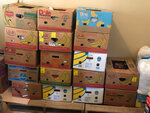
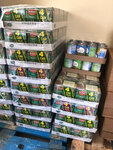
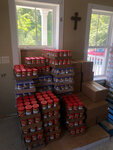
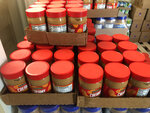
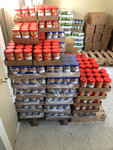

Times are tough, and the numbers don’t lie.
According to the U.S. Census Bureau’s latest Household Pulse Survey, taken in March of this year, just over one in ten adults - more than 23 million people – live in households where there was either sometimes - or often - not enough food to eat over the past week. Unfortunately, it’s happening across the nation, not sparing people and families who live Long Beach and nearby communities.
“We end up serving a lot of elderly people who are just probably on social security,” says Pat Donald, director of the Long Beach Community Food Pantry. “We see single moms with kids, people who are out of work for whatever reason.”
Donald and other food pantry volunteers have seen first-hand how the mix of local residents getting assistance from the food pantry has changed over the years, now including not only elderly or disabled people on fixed incomes, but also working families who are struggling to make ends meet. After paying for childcare, housing, transportation, utilities and other basic needs, there’s not much - or even enough - money for a rising number of residents and families to buy enough food to meet their needs.
“We are not providing their groceries. We are supplementing what they can afford to buy,” says John Sparacino, who has volunteered with the food pantry for a number of years. “We tell them not to depend on us for their primary source of food, but to be a supplement to help them out with what they already have the capability to buy.”
While the runaway inflation that began in 2021 has slowed, prices still remain far higher and continue to put a squeeze on wallets. Groceries cost about 33.5-percent more than they did at the start of the pandemic in 2020, according to Datasembly’s Grocery Price index, which tracks prices in more than 150,000 stores nationwide.
The inflation increase and substantial hike in the cost of food has hit hard and exponentially increased the demand for assistance, but the Long Beach Community Food Pantry continues its long-time mission to help alleviate food necessity shortfalls in Long Beach, Pass Christian and Kiln, providing food to qualifying residents and families to help them meet their basic nutritional needs.
“Our food comes from different sources,” Donald says. “We purchase food from Twelve Baskets, and we purchase food from some of the local grocery stores. Food also comes from the USDA. We receive food from organizations such as Extra Table. They send us a pallet of food each month. We also receive food from individuals who donate and local schools that hold food drives throughout the year.”
The church-based pantry also receives much of its monetary funding year-round from four churches in the local community.
“This really helps us revenue-wise,” Donald says. “That money goes to purchase food and some overhead expenses. No one is on salary here. Everyone is one-hundred-percent volunteers. We probably have about thirty volunteers who come out here to help on Mondays, Wednesdays and Fridays, the three days that we are open.”
Two major food drives each year also help stock the pantry.
“We have the Boy Scouts’ and Girl Scouts’ food drive in Pass Christian in February, and the U.S. Postal Service here in Long Beach does theirs in the second week of May,” Donald says.
The food pantry recently received a much-needed special boost through a special delivery from the U.S. Postal Service’s Stamp Out Hunger Food Drive, which took place on Saturday, May 11.
Sponsored by the U.S. Postal Service and National Association of Letter Carriers and held annually on the second Saturday of May, letter carriers collected donations of non-perishable food items set out by residents on their routes. The donated food arrived at the pantry just in time, considering food levels were almost depleted at that point.
“We want to be sure to thank the U.S. Postal Service, our local letter carriers and the folks who live here in Long Beach for what they donated, because we received approximately 470 pounds of donated food from the Stamp Out Hunger Food Drive in May,” Donald said.
“Last year, in these three communities [Long Beach, Pass Christian and Kiln], we served 898 families,” Donald says. “We allow these families to come in once every thirty days.”
For long-time, dedicated volunteers like John Sparacino, no salary is needed, because he says this “work” is his calling and gives a sense of purpose, while “paying back” dividends.
“I’ve been doing this for so many years,” Sparacino says. “It’s just rewarding to help the people who come in here that you see. They are really in need and appreciate what you’re helping them with.”
The struggle is real, but help is available to local residents and families who qualify.
Applications can be picked up and turned in at the Long Beach Community Food Pantry, which is located at 21081 Johnson Road in Long Beach, across from the old vacuum plant. The pantry is open on Mondays, Wednesdays and Fridays (except for national holidays) from 10 a.m. to 2:30 p.m.
Those who qualify for food pantry assistance can pick up food donations from the pantry once a month.
“You have to fill out an application,” Donald says. “That’s a requirement, and that application meets the USDA’s poverty guidelines for food.”
According to the USDA’s 2024 federal poverty level guidelines, an individual who makes $15,060 or less a year qualifies for the program. The threshold for couples and families are $20,440 or less for a family of two, $25,820 or less for a family of three, $31,200 or less for a family of four, $36,580 or less for a family of five, $41,960 or less for a family of six, $47,340 or less for a family of seven and $52,720 or less for a family of eight. For families over eight people, the threshold increases by $5,380 for each additional person.
“Walk in the front door. You can bring food [donations] here through the front door, too,” Donald says with a smile, as he describes a “regular” angel who visits the pantry often to give and not receive.
“He probably spends $300 or $400 a month on food and brings it in here,” Donald says.
The Long Beach Food Community Food Pantry is always in need of food and monetary donations, as well as volunteers to work either morning or afternoon shifts. The pantry collects and gives out canned goods, non-perishables, such as cornbread mix, grits, soup and canned fruits, as well as other food items, such as eggs and frozen food, when available.
For more information on donating, volunteering, or signing up for assistance, visit the Long Beach Community Food Pantry on Facebook, or call 228-861-1291.